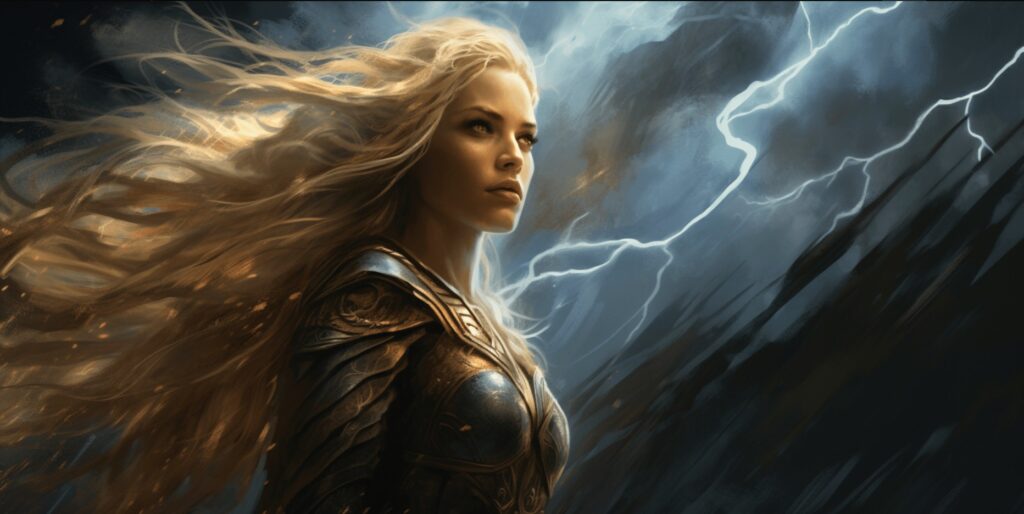Blog, Tales of the Gods
The Norse Goddess of Lightning: Unveiling the Power of the Deity
Norse mythology is a realm filled with formidable gods and goddesses, each embodying unique powers and playing a significant role in the cosmic order. Among the esteemed pantheon, the Norse Goddess of Lightning stands as an electrifying and awe-inspiring figure. In this captivating journey, we delve into the world of Norse mythology to explore the enigmatic Goddess of Lightning, understanding her attributes, significance, and enduring legacy.
Norse Mythology – A Pantheon of Deities
At the heart of Norse culture lies a diverse pantheon of gods and goddesses, representing different aspects of the natural world and human experiences. These divine beings played a crucial role in the lives of the ancient Norse people, as they sought protection, guidance, and blessings from the gods they worshipped.
Meet the Norse Goddess of Lightning
Known by various names like Sif, Þórr’s Wife, or the Thundering Goddess, the Norse Goddess of Lightning holds a significant place in the divine hierarchy. Her association with Thor, the God of Thunder, further highlights her relevance in the realm of natural phenomena, particularly thunder and lightning.
Thor and the Goddess of Lightning
Thor, the mighty God of Thunder, is often depicted wielding his formidable hammer, Mjölnir, creating thunder and lightning storms as he traverses the heavens. The Goddess of Lightning shares a close bond with Thor, her powers complementing and amplifying the grandeur of his thunderous exploits.
Origins and Creation Story
The mythical origins of the Goddess of Lightning trace back to ancient Norse tales, where her divine lineage is revealed. As the spouse of Thor, she is intricately connected to the lineage of the Æsir gods, and her story unfolds in the midst of grand cosmic events.
Powers and Realm
One of the most notable aspects of the Goddess of Lightning is her electrifying powers. As the mistress of lightning, she commands the dazzling force of nature, bringing thunderstorms and wielding bolts of lightning with awe-inspiring might. Her realm within the Norse cosmos is filled with celestial wonders and natural phenomena, reflecting her awe-inspiring power.
Symbolism and Iconography
In Norse culture, symbols held profound significance, and the Goddess of Lightning is no exception. Her iconography is adorned with representations of lightning, thunder, and celestial elements, embodying her status as the divine ruler of natural forces. Understanding the symbolism associated with her provides deeper insights into her role in Norse belief.
Myths and Legends
Throughout Norse mythology, numerous myths and legends feature the Goddess of Lightning, chronicling her heroic exploits and divine interventions. Her stories narrate epic battles, protection of mortals, and the preservation of cosmic order, solidifying her position as a revered and influential deity.
Worship and Rituals
In ancient Norse society, worship of the gods and goddesses was an integral part of daily life. As the Goddess of Lightning, she garnered reverence and devotion from the people, who sought her protection from storms and the blessings of thunder and lightning for their crops and endeavors.
Comparisons with Lightning Deities in Other Cultures
The concept of lightning deities is prevalent in various mythologies worldwide. Comparing the Norse Goddess of Lightning with lightning deities from other cultures allows for a broader understanding of the universal fascination with natural phenomena and their divine embodiments.
The Goddess of Lightning in Modern Culture
Though rooted in ancient myths, the influence of the Goddess of Lightning extends into modern times. From literature to art and popular media, her electrifying persona continues to captivate and inspire creators, preserving her legacy in contemporary culture.
The Legacy of the Goddess of Lightning
As we conclude our exploration, the Goddess of Lightning remains an enduring symbol of power and natural forces in Norse mythology. Her electrifying presence and divine influence continue to resonate across cultures and inspire awe and wonder in the hearts of those who delve into the captivating world of Norse deities.
Conclusion
The Norse Goddess of Lightning stands as a formidable and revered figure in the Norse pantheon, embodying the raw power of thunder and lightning. Through her myths and legends, she represents the awe-inspiring forces of nature and holds an enduring place in the hearts and imaginations of those enchanted by the captivating realm of Norse mythology. Her legacy as a goddess of tremendous power and influence continues to shine brightly in the

